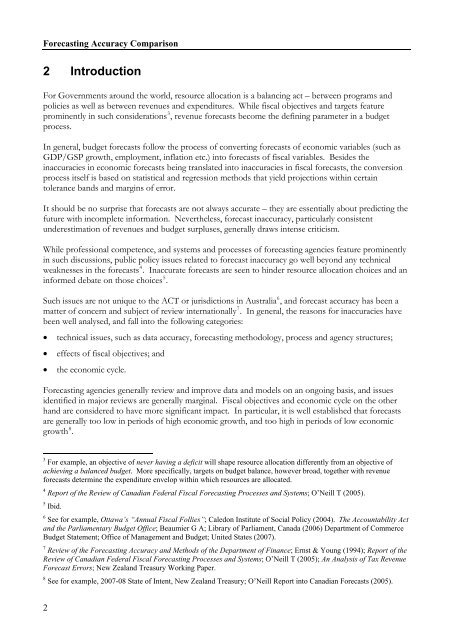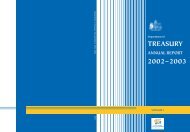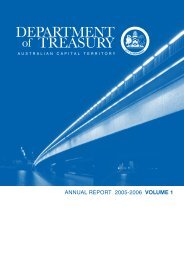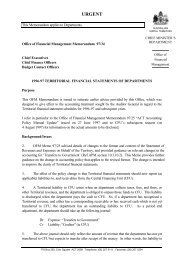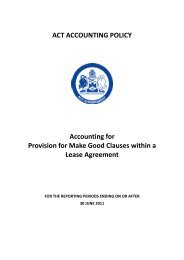Forecasting Accuracy - ACT Budget.pdf - Treasury
Forecasting Accuracy - ACT Budget.pdf - Treasury
Forecasting Accuracy - ACT Budget.pdf - Treasury
You also want an ePaper? Increase the reach of your titles
YUMPU automatically turns print PDFs into web optimized ePapers that Google loves.
<strong>Forecasting</strong> <strong>Accuracy</strong> Comparison<br />
2 Introduction<br />
For Governments around the world, resource allocation is a balancing act – between programs and<br />
policies as well as between revenues and expenditures. While fiscal objectives and targets feature<br />
prominently in such considerations 3 , revenue forecasts become the defining parameter in a budget<br />
process.<br />
In general, budget forecasts follow the process of converting forecasts of economic variables (such as<br />
GDP/GSP growth, employment, inflation etc.) into forecasts of fiscal variables. Besides the<br />
inaccuracies in economic forecasts being translated into inaccuracies in fiscal forecasts, the conversion<br />
process itself is based on statistical and regression methods that yield projections within certain<br />
tolerance bands and margins of error.<br />
It should be no surprise that forecasts are not always accurate – they are essentially about predicting the<br />
future with incomplete information. Nevertheless, forecast inaccuracy, particularly consistent<br />
underestimation of revenues and budget surpluses, generally draws intense criticism.<br />
While professional competence, and systems and processes of forecasting agencies feature prominently<br />
in such discussions, public policy issues related to forecast inaccuracy go well beyond any technical<br />
weaknesses in the forecasts 4 . Inaccurate forecasts are seen to hinder resource allocation choices and an<br />
informed debate on those choices 5 .<br />
Such issues are not unique to the <strong>ACT</strong> or jurisdictions in Australia 6 , and forecast accuracy has been a<br />
matter of concern and subject of review internationally 7 . In general, the reasons for inaccuracies have<br />
been well analysed, and fall into the following categories:<br />
• technical issues, such as data accuracy, forecasting methodology, process and agency structures;<br />
• effects of fiscal objectives; and<br />
• the economic cycle.<br />
<strong>Forecasting</strong> agencies generally review and improve data and models on an ongoing basis, and issues<br />
identified in major reviews are generally marginal. Fiscal objectives and economic cycle on the other<br />
hand are considered to have more significant impact. In particular, it is well established that forecasts<br />
are generally too low in periods of high economic growth, and too high in periods of low economic<br />
growth 8 .<br />
3 For example, an objective of never having a deficit will shape resource allocation differently from an objective of<br />
achieving a balanced budget. More specifically, targets on budget balance, however broad, together with revenue<br />
forecasts determine the expenditure envelop within which resources are allocated.<br />
4 Report of the Review of Canadian Federal Fiscal <strong>Forecasting</strong> Processes and Systems; O’Neill T (2005).<br />
5 Ibid.<br />
6 See for example, Ottawa’s “Annual Fiscal Follies”; Caledon Institute of Social Policy (2004). The Accountability Act<br />
and the Parliamentary <strong>Budget</strong> Office; Beaumier G A; Library of Parliament, Canada (2006) Department of Commerce<br />
<strong>Budget</strong> Statement; Office of Management and <strong>Budget</strong>; United States (2007).<br />
7 Review of the <strong>Forecasting</strong> <strong>Accuracy</strong> and Methods of the Department of Finance; Ernst & Young (1994); Report of the<br />
Review of Canadian Federal Fiscal <strong>Forecasting</strong> Processes and Systems; O’Neill T (2005); An Analysis of Tax Revenue<br />
Forecast Errors; New Zealand <strong>Treasury</strong> Working Paper.<br />
8 See for example, 2007-08 State of Intent, New Zealand <strong>Treasury</strong>; O’Neill Report into Canadian Forecasts (2005).<br />
2


